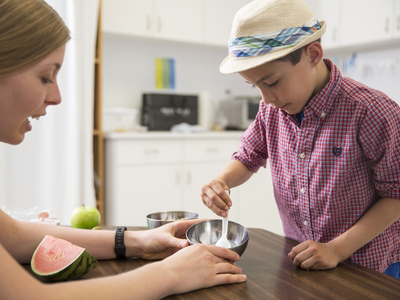Top Ten Myths of Mealtime in America

There are many misconceptions about mealtime. For families who have trouble during mealtime. Clarifying these misconceptions can be very helpful to ease feeding difficulties at during meals.
MYTH #1 = Eating is the Body’s number 1 priority.
Why it is false...
Actually, BREATHING is the Body’s number 1 priority. Without good oxygenation, eating difficult because we shut off our airway briefly with every swallow and our oxygen level decreases slightly (or we have to significantly increase our respiratory rate to maintain oxygen such that we are burning off any calories we take in). POSTURAL STABIITY (“not falling on your head”) is actually Body priority number 2. Eating is only Body priority number 3. If either breathing or postural stability are compromised, eating may be resisted.
MYTH #2 = Eating is instinctive.
Why it is false...
Eating is only an instinctive drive for the first month of life. From birth to 3-4 months of age, we have a set of primitive motor reflexes (e.g. rooting, sucking, swallowing) which help us eat while we lay down pathways in the brain for voluntary motor control over eating. Between the end of the 5th or 6th months of life, these primitive motor reflexes “drop out” and eating is essentially a learned motor behavior after 6 months of age.
MYTH #3 = Eating is easy.
Why it is false...
Eating is the MOST complex physical task that human beings engage in. It is the ONLY human task which requires every one of your organ systems, and requires that all of those systems work correctly. In addition, EVERY muscle in the body is involved (one swallow for example, takes 26 muscles and 6 cranial nerves to coordinate). Plus, eating is the ONLY task children do which requires simultaneous coordination of all 8 of our sensory systems. Learning, Development, Nutrition and the Environment also have to be integrated in to make sure a child eats correctly.
MYTH #4 = Eating is a two step process; 1 = you sit down, 2 = you eat.
Why it is false...
There are actually about 25 steps for typically developing children and 32 steps or more for children with feeding problems, in the process of learning to eat (see the Steps To Eating handout).
MYTH #5 = It is not appropriate to touch or paly with your food.
Why it is false...
Wearing your food is part of the normal developmental process of learning to eat it. You can learn a great deal about the foods, BEFORE they ever get into your mouth, by touching them and playing with them first. It is “play with a purpose” that teaches a child the “physics of the foods” before the foods ever get into their mouth. Being messy is an important part of learning to eat.
MYTH #6 = If a child is hungry enough, he/she will eat. They will not starve themselves.
Why it is false...
This is true for about 94-96% of the pediatric population. For the other 4-6% of the pediatric population who have feeding problems, they will “starve” themselves (usually inadvertently however). For the majority of children with feeding difficulties, eating doesn’t work and/or it hurts, and NO amount of hunger is going to overcome that fact. Children are organized simply; if it hurts, don’t do it. If it doesn’t work; cry and/or run away. Also, for children who have skill or medical problems with eating, their appetite often becomes suppressed over time, such that they no longer respond correctly to appetite as a cue to eat a sufficient number of calories.
MYTH #7 = Children only need to eat 3 times a day.
Why it is false...
In order to meet their daily calorie requirements, children would have to eat adult sized meals if they only eat 3 times a day. Given their small stomachs and attention spans, it takes most children 5-6 meals a day to get in enough calories for proper growth and development.
MYTH #8 = IF a child won’t eat, they EITHER have a behavioral OR an organic problem.
Why it is false...
Various research studies, and the data from our Center, indicates that between 65-95% of all children with feeding problems have a COMBINATION of behavioral AND organic problems. If you start with a physical problem with eating, you are going to quickly learn that eating doesn’t work/hurts and a set of behaviors to avoid the task will become set into place. If you start with a purely behavioral/environmental reason for not eating, your compromised nutritional status or lack of experience will quickly begin to cause organic problems. As such, it is not useful to create a dichotomy in diagnosing or treating feeding problems.
MYTH #9 = Certain foods are only to be eaten at certain times of the day (ie. Breakfast foods only for breakfast, lunch foods only at lunch, snack foods only at snacks, dinner foods only for dinner), and only certain foods are “good for you”.
Why it is false...
Food is just food. It is not breakfast food, or lunch food, or dinner food, or snack food, or junk food. Food is either a protein, a carbohydrate or a fruit/vegetable. While some foods do have more nutritional value than others, labeling foods as “good” or “bad” or “only to be eaten at X meal”, is not helpful in teaching children to eat or to have a healthy relationship with food. If a child eats chicken and peas best at breakfast, that is okay. In addition, the so called “junk” foods actually play a huge role as stepping stones in teaching children with feeding difficulties to learn to eat a wide variety of other foods because these “junk” foods are typically easy to manage from an oral-motor standpoint, and/or they have a large sensory appeal.
MYTH #10 = Mealtimes are a proper social occasion. Children are to “mind their manners” at all meals.
Why it is false...
Actually, eating comes first. Manners come second. The skills for eating need to be learned first, before children can have good manners. Think about the 6-9 month old infant just learning to eat and how messy they get. Especially for children who have not learned to eat well, mealtimes are a Teaching Opportunity and we parents are the Teachers. Children eat so much better when their food is engaging, interesting and attractive. They also eat better when mealtime conversations are focused on talking about the food, and when adults are modeling how to eat and teaching the “physics” of food. So go ahead, enjoy your food and the feeding experience with your child! Be noisy, be messy and play with your food!!
Copyright 1997 / 2010 Dr. Kay A. Toomey
Learn How to Know if Your Child Has a Feeding Problem
 Dr. Kay Toomey is a pediatric psychologist who has worked for nearly 30 years, with children who don’t eat. She is the developer of the highly effective, family-centered SOS Approach to Feeding in successful use worldwide to assess and treat children with feeding problems. In addition to directing SOS Feeding Solutions at STAR Institute, Dr. Toomey speaks nationally and internationally about her approach. She also acts as a consultant to Gerber Products. Dr. Toomey helped establish The Children’s Hospital Pediatric Oral Feeding Clinic in Denver and Rose Medical Center’s Pediatric Feeding Center, also in Denver. Dr. Toomey co-chaired the Pediatric Therapy Services Department at Rose Medical Center prior to entering private practice. She is currently the president of Toomey & Associates, Inc., which provides her speaking services.
Dr. Kay Toomey is a pediatric psychologist who has worked for nearly 30 years, with children who don’t eat. She is the developer of the highly effective, family-centered SOS Approach to Feeding in successful use worldwide to assess and treat children with feeding problems. In addition to directing SOS Feeding Solutions at STAR Institute, Dr. Toomey speaks nationally and internationally about her approach. She also acts as a consultant to Gerber Products. Dr. Toomey helped establish The Children’s Hospital Pediatric Oral Feeding Clinic in Denver and Rose Medical Center’s Pediatric Feeding Center, also in Denver. Dr. Toomey co-chaired the Pediatric Therapy Services Department at Rose Medical Center prior to entering private practice. She is currently the president of Toomey & Associates, Inc., which provides her speaking services.
